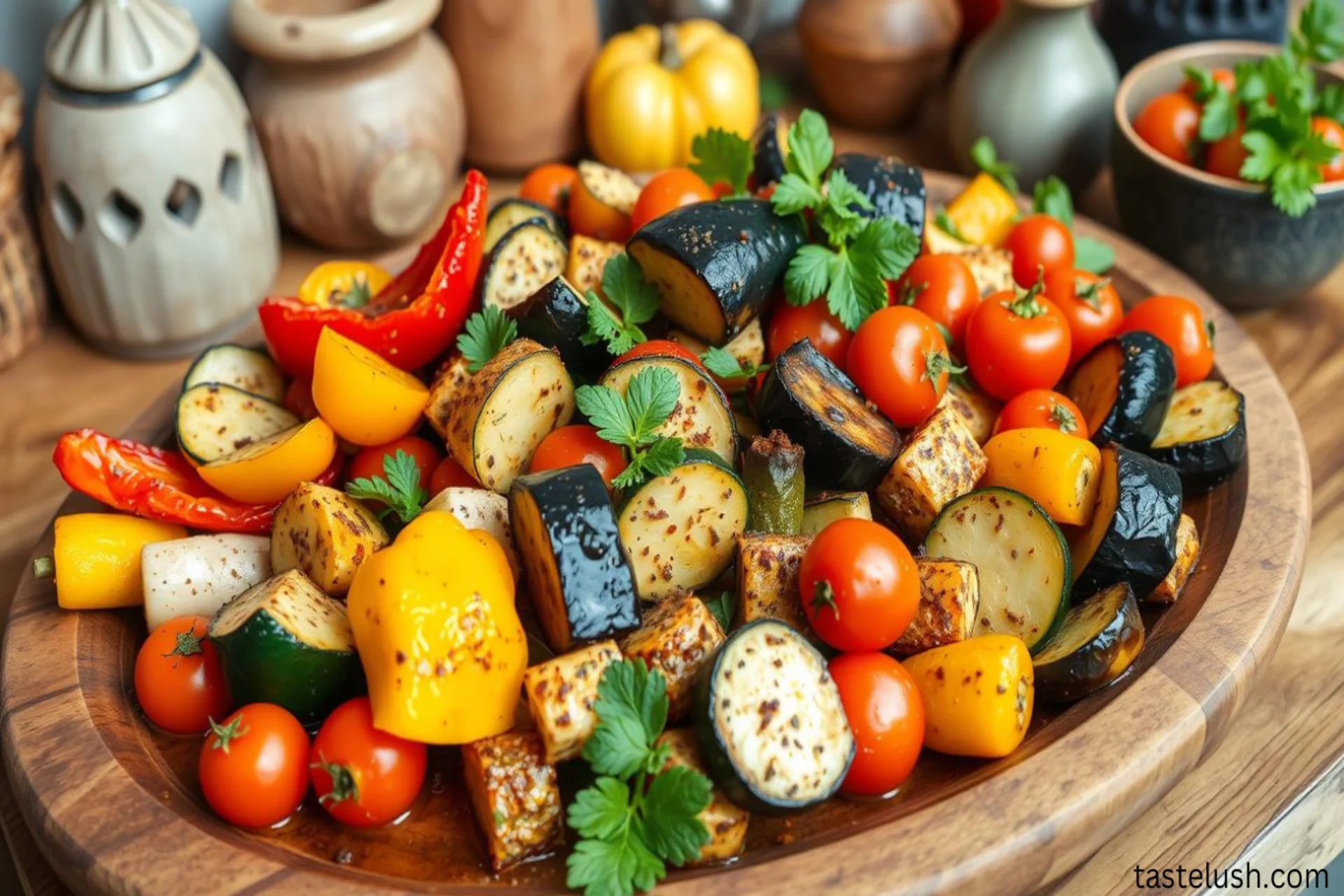Enjoy a Middle Eastern Style Roasted Vegetables Recipe and extend your palate with the delicious oriental food spices. An assortment of Mediterranean vegetables that are delicious and warming, with spices that are sure to stick with your taste buds. It’s ideal to be served beside grains or as a dinner dish and leads you through the Middle Eastern food experience.
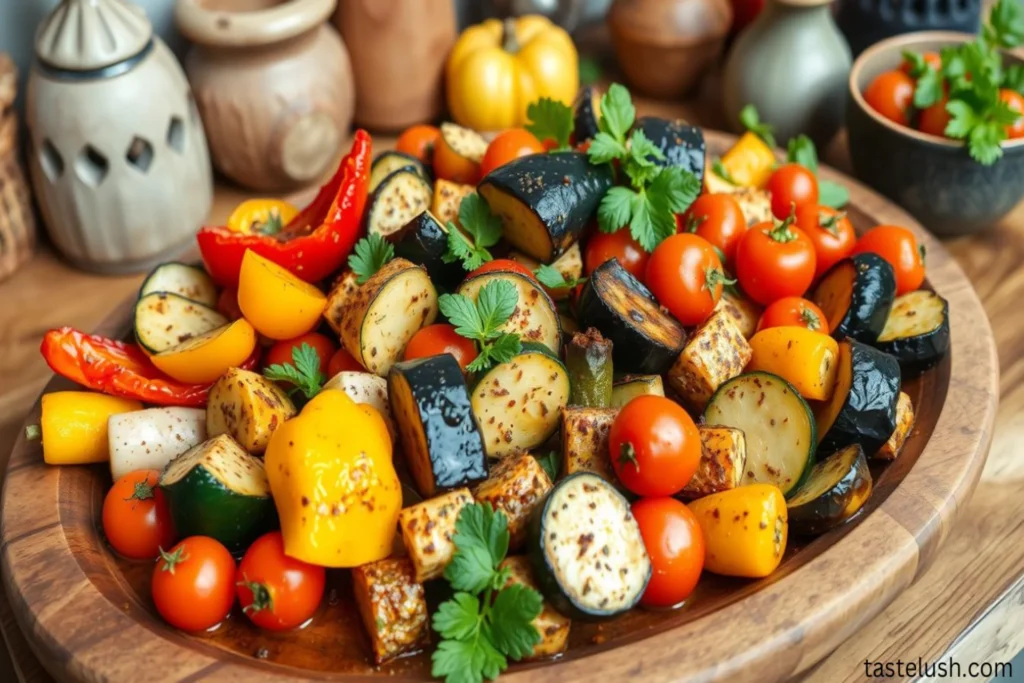
The array of Middle Eastern roasted vegetables; bell peppers, zucchini, and eggplant alongside cherry tomatoes and other such lovely actors for the dish, seasoned with cumin and coriander. The vegetables are presented nicely inside a wooden turnover and sprinkled with fine parsley and mint accompanied by olive oil clearly depicting the comforting atmosphere.
Table of Contents
Key Takeaways
- Add some spices to your diet and learn how to prepare roasted vegetables in Middle Eastern style.
- Savor an exquisite nutritious addition to your meals or a standalone meal.
- Encounter how cuisine from the Mediterranean has rich cultural rewards and healthy nutritional values for people.
- Find out potential ingredients and temperate for roasting that yields the best results
- Adapt it according to your desires and requirements of your meals
Introduction to Middle Eastern Roasted Vegetables
Middle Eastern style is characterized by tasty spicy products and vegetables which are considered to be very healthy. An important preamble to this tradition involves the roasting of vegetables. That is why it makes even simple ingredients transform into delicious meals. This recipe for Middle Eastern-style roasted vegetables recognizes what is in Middle Eastern cuisine.
Origins and Cultural Significance
The use of roast vegetables in Middle Eastern meals can be dated back for years now.I will indicate that they depict the regions, especially its agriculture and the way people treated it. Roasted zucchini, eggplant, and pepper smells are well embraced in Middle Eastern cuisines.
This recipe ties us to the cooking traditions of the region. It takes a lot of the tastes we relished in the past to our plates today.
Health Benefits of Mediterranean Cooking
Roasted vegetables can trace their origins back to the different periods of Mesopotamian and Ancient Egyptian cuisine. They demonstrate how the area has been fruitful in agriculture and how the people valued soil. Roasted zucchini, eggplant, and bell peppers smell is an inherent tradition of Middle Eastern aromas.
This recipe helps us tie into the area’s cultural ways of preparing foods. It makes the dishes we consume today take origins from the early past.
Why This Recipe Works
This roasted vegetable recipe as a Middle Eastern dish deserves attention for numerous reasons. It incorporates a whole mix of extra, comprising of cumin, coriander, and lemon. These spices increase the taste quotient of the vegetables by a notched level.
In the roasting method, the texture and natural sweetness of the vegetables is maintained. The marinade actually makes them even tastier. This recipe is a one-stop shop to Middle Eastern meals and perfect for anyone who wants to indulge in a healthy meal.
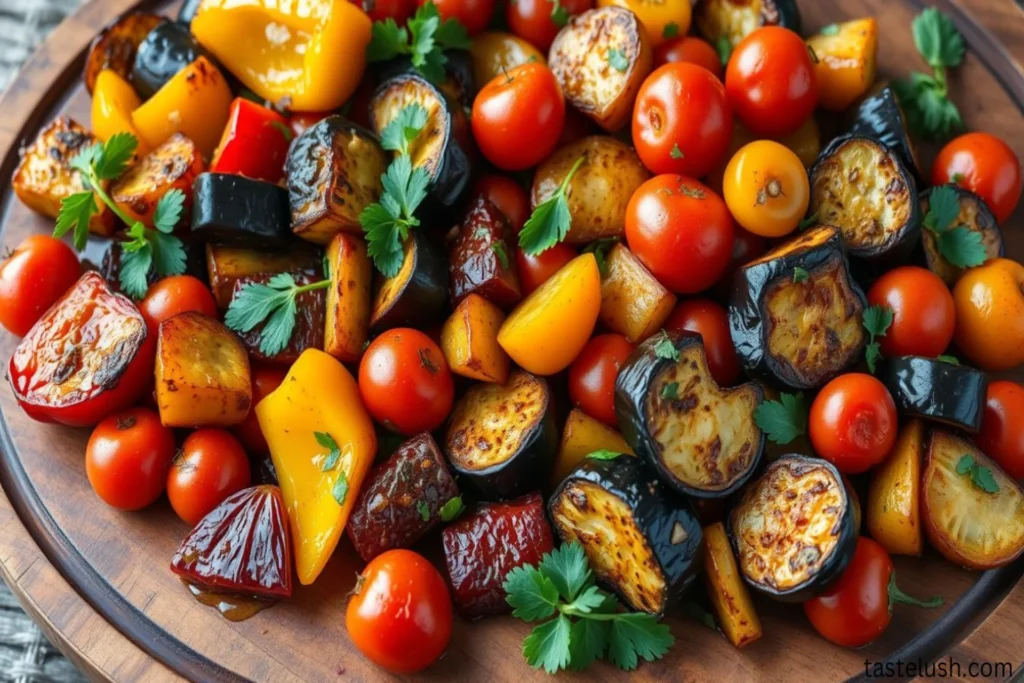
A colorful range of Middle Eastern roasted vegetables, peppers, zucchini, aubergines, and cherry tomatoes, are attractively displayed on a wooden platter, dressed with olive oil with a hint of spices such as za’atar and cumin with Fresh parsley and mint Herbs in the Mediterranean context.
‘Grilled vegetables are staple foods of Middle East, which represent an appetizing and healthful link to the history of the region’s food.’
Essential Ingredients and Spice Combinations
A guide to preparing a tasty Middle Eastern roasted vegetable recipe is to use the right ingredients and spices. There is no artificial coloring, flavoring, or preservative used; the colors result from natural foods such as vegetables; the spices are aromatic Middle Eastern ones, and instead of using butter, the dish is cooked in olive oil. The vegetables are the main components of this recipe. Select fresh, colorful, and local vegetables like zucchini, eggplant, bell peppers, and onions during the particular season, right ingredients and spices. The flavors come from fresh vegetables, aromatic Middle Eastern spices, and rich olive oil.
The base of the recipe is the vegetables. Choose colorful, seasonal produce like zucchini, eggplant, bell peppers, and onions. These are fresh foods that can be prepared further, they contain nutrients that will be cooked with other ingredients shortly.
That is where Middle Eastern cuisine shines; using spices to add flavor to the food. This dish uses spices such as za’atar and sumac all of which add to the taste of the food. There is a tangy or rather earthy taste obtained from Thyme, sesame, and sumac in Za’atar. Sumac gives a sour, lemony taste which makes it unique and rich. It also adds some tang to the bass and connects those flavors to the olive oil. The roasted vegetable dish starts with the right ingredients and spices. The flavors come from fresh vegetables, aromatic Middle Eastern spices, and rich olive oil.
The base of the recipe is the vegetables. Choose colorful, seasonal produce like zucchini, eggplant, bell peppers, and onions. These ingredients are fresh and full of nutrients, ready for future flavors.
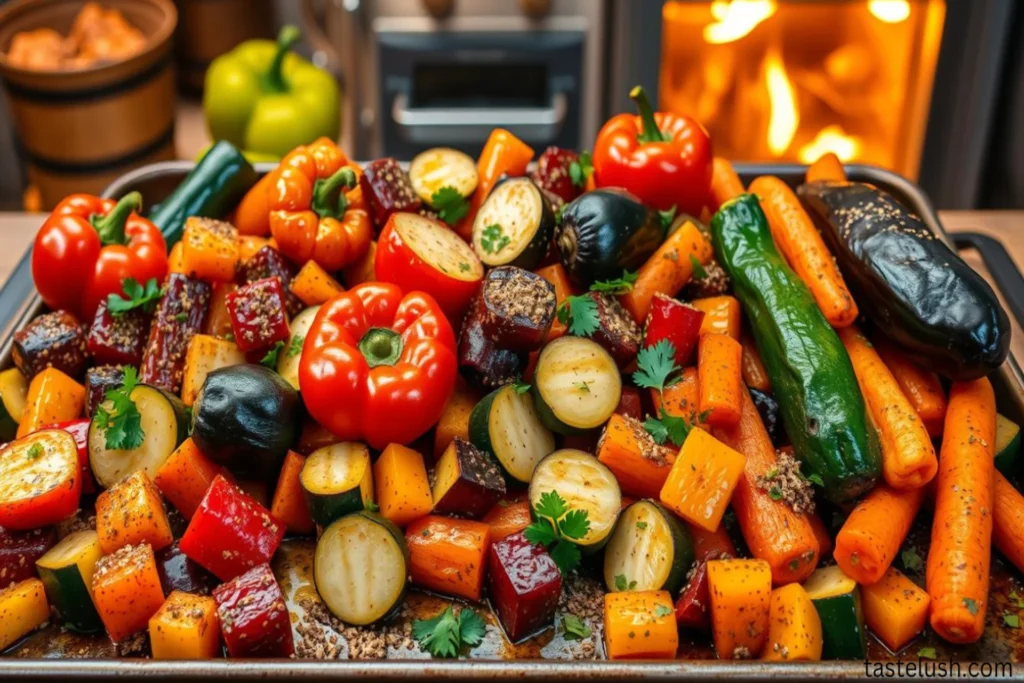
The spice blend is where Middle Eastern cuisine truly comes alive. Spices like za’atar and sumac give the dish its unique taste. Za’atar adds a tangy, earthy flavor with thyme, sesame seeds, and sumac. Sumac brings a tart, lemony taste, adding depth and complexity.
The olive oil ties everything together. It assists the vegetables develop a browned surface or a caramelized outside. It also relocates the aromatic spices and distributes them all over the dish.
Epicenter A colorful collection of Middle Eastern spices placed in individual bowls encompassing cumin, coriander, paprika sumac, and saffron. Use raw-colored vegetables like cilantro and parsley and position them in a wooden background along with scattered raw vegetables like eggplant bell peppers and zucchini around the bowls. The scene should bring feelings of warmth and the great kitchen heritage of Middle Eastern countries.
If you choose and combine these basic ingredients you can prepare delicious roasted vegetables which reflect Middle Eastern cuisine. fresh herbs like cilantro and parsley, with a rustic wooden background and scattered raw vegetables such as eggplant, bell peppers, and zucchini around the bowls. The scene should evoke warmth and the rich culinary traditions of the Middle East.
By choosing and mixing these key ingredients, you can make a roasted vegetable dish that truly captures the essence of Middle Eastern flavors.
Middle Eastern Style Roasted Vegetables Recipe
Preparation and Marination Tips
To get perfect Middle Eastern-style roasted vegetables, begin with fresh, seasonal vegetables. Select bell peppers, eggplant, zucchini as well as onions. Wash them and then cut into small pieces so that the food is cooked evenly.
It’s the marinade that gives the Libyan way of preparing this dish its unique taste. Stir in olive oil, lemon juice, and garlic with other Middle Eastern spices such as cumin and coriander. bles. Choose bell peppers, eggplant, zucchini, and onions. Wash and chop them into small pieces for even cooking.
The marinade is key for flavor. Mix olive oil, lemon juice, garlic, and Middle Eastern spices like cumin and coriander. For a better taste, you should allow the veggies to marinate for 30 minutes to 2 hours.
Roasting Techniques and Temperature Guide
Bake the meat at 400°F (200°C) for the outside grill marks and for tender meat from within. Spread the veggies onto a large baking sheet so that there is room for equal cooking of the ingredients.
The roasting takes approximately 20-25 minutes and it’s done by turning the pieces at the midway point. Keep an eye on them not to weld or burn. They should be soft and slightly burnt.
Seasoning and Flavor Enhancement
It is advisable to roast some foods and then add some salt and black pepper for a delicious taste after roasting. To give it a more Middle Eastern flavor, you may sprinkle it with parsley or cilantro top it. Then serve with pomegranate molasses or tahini sauce.ra flavor. For a Middle Eastern touch, garnish with parsley or cilantro. Drizzle with pomegranate molasses or tahini sauce.
This is how to prepare a Middle Eastern–style roasted vegetable recipe: It will impress your guests.
Cutting board with a plethora of Middle Eastern vegetables and dishes such as bell peppers, zucchinis, eggplants, carrots seasoned with olive oil, za’atar, dried herbs, garlic, onion, and cumin with carrots, and coriander in the background, bright and warm kitchen with an oven on in the background.
Serving Suggestions and Accompaniments
Really pull off the Middle Eastern style of your roasted vegetables and serve your dish with some great sides and garnishing. This recipe is best complemented by hummus and tahini sauce. For a proper look of the same platter, also top it with warm pita bread which is characteristic of Middle Eastern foods. accompaniments. The flavors of this recipe go well with hummus and tahini sauce. Add warm pita bread for a classic mezze platter look that highlights Middle Eastern cuisine.
For a full meal, try these tasty Middle Eastern side dishes to make your meal even better:
Tabbouleh salad in a fresh form with parsley, bulgur, and lemon
Greek tzatziki – a refreshing cucumber and yogurt salad
Flavorful basmati rice or roasted green wheat called freekeh
Olives preserved in olive oil accompanied by pickled vegetables
| Accompaniment | Flavor Profile | How it Enhances the Dish |
|---|---|---|
| Hummus | Creamy, nutty, and garlicky | Provides a rich, creamy contrast to the roasted vegetables |
| Tahini sauce | Tangy, sesame-forward, and zesty | Adds a flavorful, textural complement to the roasted vegetables |
| Pita bread | Warm, soft, and lightly toasted | Serves as a vehicle to scoop up the roasted vegetables and sauces |
These Middle Eastern side dishes and accompaniments make the meal look colorful, appetizing, and with a delicious flavor. It is the approach through which people can fully capture the Themed repast needs of this diverse culinary genre.
Variations and Customizations
Here is a Middle Eastern-style roasted vegetable; this recipe is very genial. It’s especially good for those who pursue vegetarian directions, vegan substitutions, or those who decide to bake something using only seasonal vegetables available. an option, vegan adaptations, or just want to use seasonal vegetables. They can easily tweak it according to many different dieters and their preferences. For vegetarians, you can substitute chicken or lamb for tofu or chickpeas. To make it vegan simply omit the yogurt marinade and use a plant-based dressing of your choice. fact for those who follow vegetarian options, vegan adaptations, or just want to use seasonal vegetables. It can be adjusted to fit many different diets and tastes.
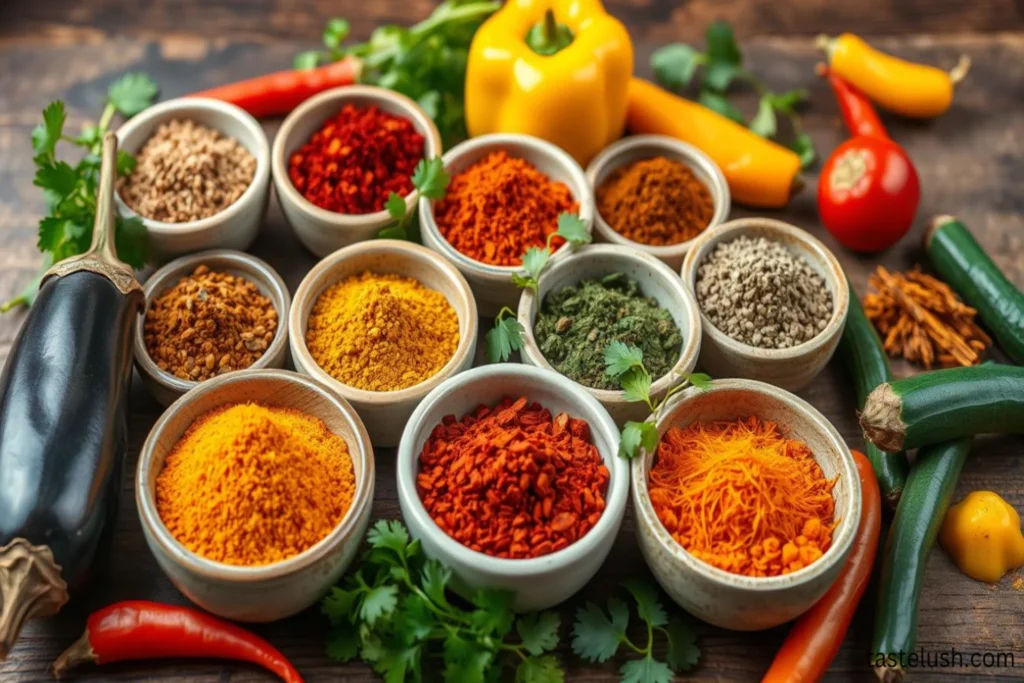
For vegetarians, you can replace chicken or lamb with tofu or chickpeas. To make it vegan, just skip the yogurt marinade and use a plant-based dressing. You can also swap the type of vegetables with the different seasons as well. For instance, you should consider using zucchini, eggplant, and bell peppers when the weather is hot. In winter, more suitable will be carrots, beets, and parsnips with somewhat changed taste.
Choose tofu or chickpeas as an alternative for a vegetarian/vegan dietReplace the yogurty marinade with any plant-based dressing to gear it towards the vegan option can be done by using the seasonal vegetables since this will give the dish a new feel at every particular season of the year. plant-based dressing for a vegan adaptation
Experiment with seasonal vegetables to keep the dish fresh and flavorful throughout the year
This roasted vegetable recipe has a flair of Middle Eastern and can be modified to suit each and everyone’s requirements depending on their diet. You can easily perform this colorful, healthy meal at your home by making some minor changes:
Conclusion
This roasted vegetable dish inspired by Middle Eastern cuisine is a quick, healthy, and easy method to introduce Mediterranean cuisine into your diet. This recipe consists of crisp aromatic spices along with tender vegetables, which makes it the perfect fit for all the Mediterranean diet lovers out there.. It combines aromatic spices with tender vegetables, making it a great choice for those who love healthy Mediterranean recipes.
Planning a meal that calls for a side dish or an entree? That is why this recipe is guaranteed to amaze you). It can make Middle Eastern cuisine flavor come straight into your kitchen with just a simple stir or a turn of the kettle spindle. We encourage you to give it a spin and let the Middle Eastern flavors come to you. hy and tasty way to add Mediterranean flavors to your cooking. It combines aromatic spices with tender vegetables, making it a great choice for those who love healthy Mediterranean recipes.
Looking for a tasty side or a main dish? This recipe will surely impress. It brings the bold flavors of Middle Eastern cuisine right to your kitchen. We invite you to try it and enjoy Middle Eastern cuisine at home.
The saticrime and aesthetics of the dish definitely make it satisfying. It is a perfect opportunity to feel the spirit of the Mediterranean. Below is the Middle Eastern-style roasted vegetable recipe; you can enjoy the delicious meal.
FAQs
What are the origins and cultural significance of Middle Eastern roasted vegetables?
Roasted vegetables have been a big part of Middle Eastern food for centuries. They show the rich traditions and culture of the area. The mix of flavors and spices used in cooking reflects the diverse influences on Middle Eastern taste.
What are the health benefits of the Mediterranean diet and how does this recipe align with those principles?
The Mediterranean diet focuses on plants and fresh ingredients. It’s known for its health benefits. This roasted vegetable recipe fits well with the Mediterranean diet. It’s a healthy way to add more veggies to your meals.
Why does this particular Middle Eastern roasted vegetable recipe stand out?
This recipe is special because of its unique spices and versatility. It can be a side dish or a main course. The use of za’atar and sumac makes the veggies taste amazing.
What are the key ingredients and spice combinations used in this recipe?
The recipe uses fresh veggies, olive oil, and special spices. Za’atar, sumac, cumin, and coriander give it a distinct Middle Eastern flavor. This mix creates a delicious and authentic taste.
How should the vegetables be prepared and roasted for best results?
To get the best results, prepare and roast the veggies right. Wash and cut them well, marinate in spices and oil, and roast at the right temperature. This way, they’ll be tender and sweet on the outside.
What are some recommended serving suggestions and accompaniments for this dish?
Serve the roasted veggies with various dishes for a complete Middle Eastern meal. Try them with hummus, tahini sauce, and warm pita bread. Or pair them with tabbouleh or fattoush salad.
How can this recipe be customized or adapted to suit different dietary needs?
This recipe is flexible and can be changed for different diets. Vegetarians and vegans can enjoy it as a main dish. You can also pick veggies based on the season or dietary needs, like gluten-free or low-carb.
